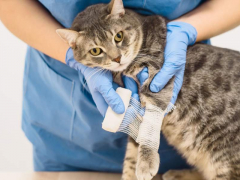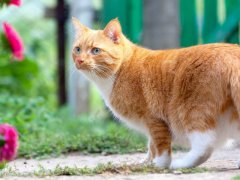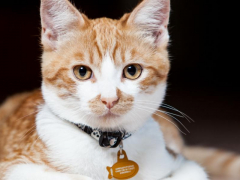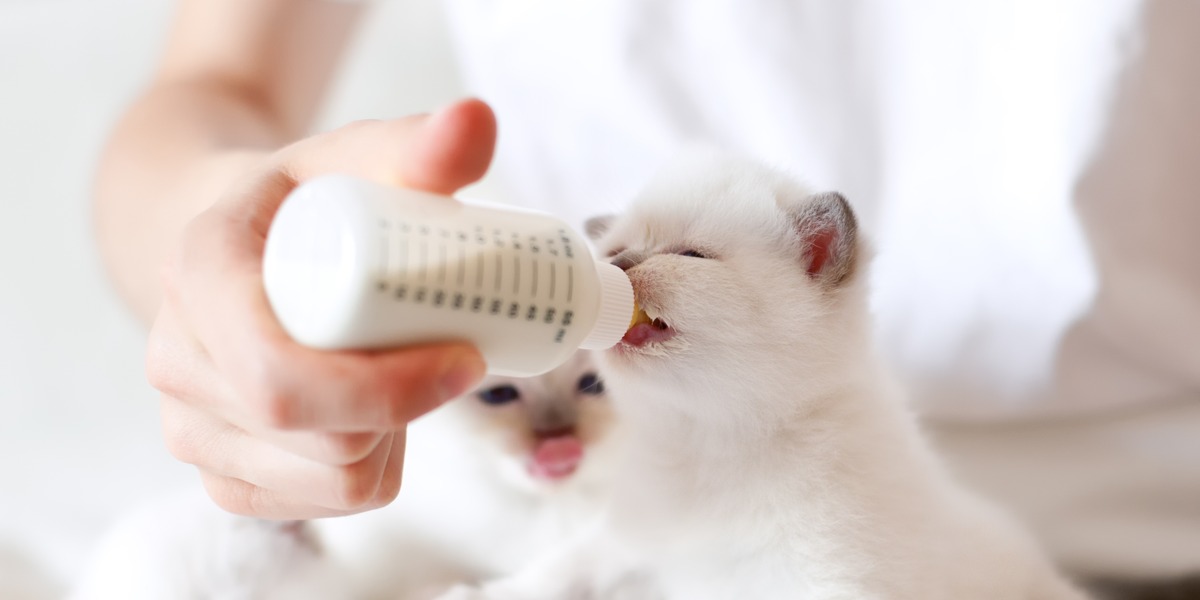
Most newborn kittens are reared by their mothers, which is ideal. However, there are some circumstances where this is not possible, and humans need to step in to give assistance.
Examples include:
- Orphaned kittens who cannot suckle their mother because she is dead, or ill
- Neonatal kittens rejected by the queen
- Young kittens found abandoned
These baby kittens need constant, careful care from humans, including nutritional support, until they are weaned. This means that bottle feeding is essential until they are weaned at four weeks of age or so.
Bottle babies are often more vulnerable to disease and infections, because if they miss their mother’s milk in the first few days after birth (colostrum) they miss out on the important immunity-enhancing antibodies that are contained in this first milk.
Bottle feeding may also be used as a way of giving supplementary nutrition if a mother cat is not giving her offspring enough milk e.g. if she is unwell, or if there is a very large litter.
How to Bottle Feed a Kitten in 7 Simple Steps
This article aims to explain the essential information about bottle feeding kittens in a way that is clear and easy to understand for cat carers.
1. Equipment You’ll Need
You need to make two purchases at your veterinarian or pet shop:
- A feeding bottle: a small bottle, with an appropriately sized rubber nipple, is essential.
Feeding formula: Cow’s milk is not sufficient for kittens, just as it is not sufficient for a human baby. While it’s possible to create a home made recipe for cat milk in an emergency, it’s better to use a kitten milk replacer (KMR) formula that has been specifically designed to provide optimal nutrition for young kittens. There are various proprietary brands on the market: powder and liquid formulations are available. - The young kittens should be kept in a warm nesting box, lined with several layers of towel covered by a diaper or incontinence pad (so that a soft dry absorbent surface is in contact with the kittens). Ideally you should place a heating pad underneath the layers of towel to keep the box at the optimal temperature. Other heat sources may be used as needed: a cold kitten will not thrive.
2. Assessing the Kitten Before Feeding
Bottle fed kittens should be fed every two or three hours during the daytime: if they are fed this frequently, there should be no need to feed them during the night.
You should not wake them to feed them: leave them alone if they are sleeping. When they are hungry, they will wake up and move around. When you examine them, check their abdomens: hungry kittens have empty, tucked up abdomens, while full kittens have swollen, plump abdomens.
3. Preparing the Bottle
- Make up the solution of milk according to the instructions on the kitten formula packet. If using powder, you need to mix well to make sure that there is no clumping.
- Prepare the amount that you expect to need for 24 hours: no longer than this.
- Keep this in the fridge and only remove the amount needed for each meal at the time.
- Clean the bottle thoroughly using hot soapy water and a toothbrush after each feed, making sure you rinse it in hot water to ensure all traces of soap are removed.
- Add the milk to the bottle, ensuring that it is at the body temperature (100’F or 38’C)
If it is too cold, warm the bottle in a cup of hot water. - Do not use a microwave oven to warm milk, as this can lead to patches of milk that are too hot, with other parts of the mix being too cold.
- Always test the temperature of the milk before giving it to the kittens: place a few drops on the inside of your wrist to assess how hot it is.
- It can be helpful to lick off the drop of milk from your wrist, tasting it to be sure that the milk has not gone off.
4. Feeding Process
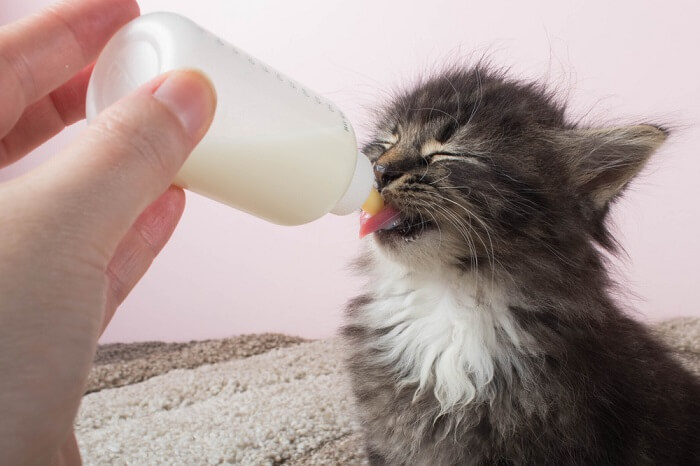
When you have finished feeding, play with the kitten for a while to encourage movement: this will assist with burping, removing gas that may have entered the stomach.
- Ensure that the bottle nipple is dripping milk reasonably easily through the small hole in its tip: if it is not, then use a needle or a pair of scissors to create a wider opening.
- Hold the bottle above and to the front, or the side, of the kitten’s head: do not feed the kitten lying on its back.
- Place the nipple in the kitten’s mouth: if they do not latch on and suck, allow a drop of formula milk drip onto their tongue so that they get the taste.
- Try to avoid letting the kitten suck air: keep the bottle at the correct angle to avoid this
- Allow the kitten to continue suckling for as long as it’s interested, then stop
- Normally the kitten’s face will start to turn away when they feel full, making it clear that they do not want any more milk.
- If you see milk coming from the nostrils, or spilling out of the mouth, then stop: you have given enough. This can be a sign of overfeeding.
- If it happens at an earlier stage of the feeding process, there is a risk that there may be a congenital problems such as cleft palate, and you should have the kitten checked by your DVM veterinarian.
5. Finishing up the Routine
When you have finished feeding, play with the kitten for a while to encourage movement: this will assist with burping, removing gas that may have entered the stomach.
Also Read: Cat Constipation: Causes, Treatment, & Remedies
It makes sense to carry out other aspects of kitten care at this time. This includes wiping under their tails with a moist cotton ball or washcloth to encourage urination and defecation (their mother normally induces this by licking them in this area). As urine and feces are passed, be sure to clean it all up thoroughly.
Remember to thoroughly clean all utensils including bottles and nipples: cleanliness around young kittens is very important as their undeveloped immune systems leave them very vulnerable at this time of life.
6. Weaning
When the kittens reach three to four weeks old, they should be weaned
- Typically, they will start to chew the bottle rather than sucking at around this time.
- Start to offer them soft food: either dry food (kibble) that has been soaked in warm water, or pate-style moist sachet/tinned wet food (ideally kitten food). Canned food may be used as long is it is mushed finely so there are no lumps.
- You may wish to mix some of this food with some milk formula, so that the taste is more familiar.
- You can continue to offer them milk feeds, but reduce then stop these between 4 and 6 weeks, as they gradually start to eat more solid food. Kittens tend to wean themselves at their own pace during the weaning process and this is fine.
Also Read: Weaning Kittens: Tips For Successful Weaning
7. Monitoring the Progress (Weight and Hydration)
- Kittens should be well hydrated: they should pass a small amount of urine and poop after every feed: you will see this when you wipe under their tails.
- Kittens should be weighed every day, and this should be written down so that you can monitor their weight gain in the first weeks of life.
- If you cannot identify each kitten individually from their markings, you should use a permanent market pen to make a dot on their body in a distinctive place.
- Healthy kittens should gain a little weight every day.
Also Read: Dehydration In Cats: Symptoms, Causes, Diagnosis & Treatment
Kitten Bottle Feeding Chart
| Age | Weight | Approximate amount per meal | Frequency of feeding |
| 0-1 week | 50 – 150g (2 – 5 oz) | 2 – 6ml (0.1 – 0.2 fl oz) | Every 2 hours |
| 1-2 weeks | 150-250g (5 – 9 oz) | 6-10ml (0.2 – 0.3 fl oz) | Every 2 – 3 hours |
| 2-3 weeks | 250-350g (9 – 12 oz) | 10-14ml (0.3 – 0.5 fl oz) | Every 3 – 4 hours |
| 3-4 weeks | 350-450g (12 – 16oz) | 14-18ml (0.5 – 0.6 fl oz) | Every 4 – 5 hours |
| 4-5 weeks | 450-550g (16 -19oz) | 18-22ml (0.6 – 0.75 fl oz) | Every 5 – 6 hours |
| 5-8 weeks | 550-850g (19 – 30 oz) | On solid food | Every 6 hours |
Other Aspects of Kitten Rearing
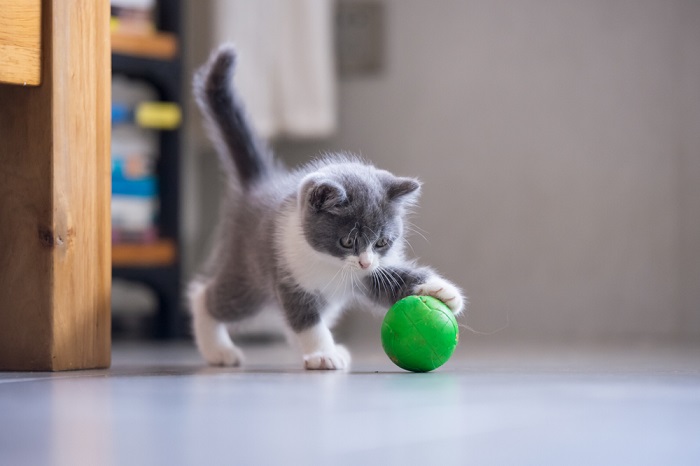
Kittens will tend to start to use a litter box from around four or five weeks of age.
Socialization is an important part of rearing young kittens: they should be exposed in a safe way to a wide range of environmental stimuli, humans, other cats, and other animals when they are young.
Kittens will tend to start to use a litter box from around four or five weeks of age.
Kittens’ Developmental Milestones
You should monitor your kittens to ensure that they are developing at around the correct rate.
- At birth, kittens weigh about 50 – 100g (2 to 4 ounces).
- They are blind and deaf, and completely dependent on their mothers (or you).
- 7 to 10 days: eyes and ears start to open, and they can see and hear.
- By three weeks: Eyes are fully open: they are always blue, but by 6 to 7 weeks of age, their eye color may change to the adult version.
- By 2 – 3 weeks: kittens start to crawl around.
- By 3 to 4 weeks: kittens start to play with each other and litter training can start.
- By 6 weeks, kittens are active, physically coordinated, curious and adventurous.
- By 8 weeks, kittens are ready for their first vaccinations and to go to their new homes.
